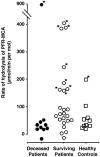High levels of catalytic antibodies correlate with favorable outcome in sepsis
- PMID: 15743915
- PMCID: PMC554824
- DOI: 10.1073/pnas.0500586102
High levels of catalytic antibodies correlate with favorable outcome in sepsis
Abstract
Sepsis is the leading cause of death in intensive care units and results from a deleterious systemic host response to infection. Although initially perceived as potentially deleterious, catalytic antibodies have been proposed to participate in removal of metabolic wastes and protection against infection. Here we show that the presence in plasma of IgG endowed with serine protease-like hydrolytic activity strongly correlates with survival from sepsis. Variances of catalytic rates of IgG were greater in the case of patients with severe sepsis than healthy donors (P < 0.001), indicating that sepsis is associated with alterations in plasma levels of hydrolytic IgG. The catalytic rates of IgG from patients who survived were significantly greater than those of IgG from deceased patients (P < 0.05). The cumulative rate of survival was higher among patients exhibiting high rates of IgG-mediated hydrolysis as compared with patients with low hydrolytic rates (P < 0.05). An inverse correlation was also observed between the markers of severity of disseminated intravascular coagulation and rates of hydrolysis of patients' IgG. Furthermore, IgG from three surviving patients hydrolyzed factor VIII, one of which also hydrolyzed factor IX, suggesting that, in some patients, catalytic IgG may participate in the control of disseminated microvascular thrombosis. Our observations provide the first evidence that hydrolytic antibodies might play a role in recovery from a disease.
Figures




References
-
- Akira, S., Takeda, K. & Kaisho, T. (2001) Nat. Immunol. 2, 675–680. - PubMed
-
- Reid, R. R., Prodeus, A. P., Khan, W., Hsu, T., Rosen, F. S. & Carroll, M. C. (1997) J. Immunol. 159, 970–975. - PubMed
-
- Ochsenbein, A. F., Fehr, T., Lutz, C., Suter, M., Brombacher, F., Hengartner, H. & Zinkernagel, R. M. (1999) Science 286, 2156–2159. - PubMed
-
- Aird, W. C. (2003) Blood 101, 3765–3777. - PubMed
-
- Paul, S., Volle, D. J., Beach, C. M., Johnson, D. R., Powell, M. J. & Massey, R. J. (1989) Science 244, 1158–1162. - PubMed
Publication types
MeSH terms
Substances
LinkOut - more resources
Full Text Sources
Other Literature Sources
Medical

